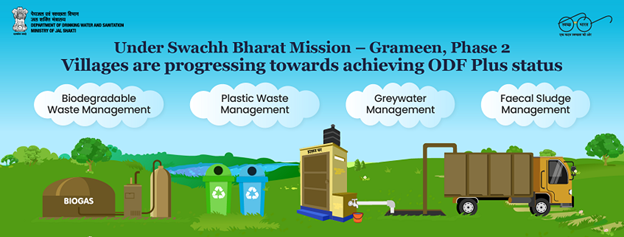From UPSC perspective, the following things are important :
Prelims level: Jal Jeevan Mission (JJM)
Mains level: Swachh Bharat Mission-Grameen (SBM-G)

Central Idea:
The article discusses the progress and challenges of India’s sanitation programs, particularly focusing on the Swachh Bharat Mission-Grameen (SBM-G) and its Phase II. It highlights the importance of behavioral change alongside infrastructure development for sustainable sanitation practices.
Key Highlights:
- Improvement in sanitation coverage in India from 39% in 2014 to 100% in 2019 under SBM-G.
- Launch of Phase II of SBM-G focusing on sustainability and ODF Plus status by 2024-25.
- Challenges including non-usage of toilets due to various reasons such as lack of infrastructure, hygiene issues, and social norms.
- Disparities in toilet access and usage across different states and socio-economic groups.
- Importance of social networks and behavioral change campaigns in promoting sanitation practices.
- Lack of synergy and coordination among various government programs addressing basic needs.
Key Challenges:
- Ensuring sustained usage of toilets post-construction.
- Addressing disparities in access and usage across different regions and socio-economic groups.
- Overcoming social norms and behaviors hindering sanitation practices.
- Lack of coordination among different government programs related to basic needs.
Key Terms/Phrases:
- Swachh Bharat Mission-Grameen (SBM-G)
- Open Defecation Free (ODF)
- Total Sanitation Campaign
- ODF Plus
- Jal Jeevan Mission (JJM)
- Social norms
- Behavioral change campaigns
Key Quotes:
- “The construction of toilets does not automatically lead to their use.”
- “Sanitation behavior also varies across socio-economic classes.”
- “Behavioral change in sanitation cannot happen independently.”
Key Examples/Anecdotes:
- Survey findings showing reasons for non-usage of toilets in different regions.
- Observations on the influence of social networks on sanitation behavior.
Key Statements:
- “Improvement in sanitation coverage needs to be viewed from the perspective of behavioral change for true sustainability.”
- “Social norms and economic conditions significantly influence toilet usage.”
Key Facts/Data:
- Sanitation coverage improved from 39% in 2014 to 100% in 2019 under SBM-G.
- NARSS-3 reported 95% toilet access but only 85% usage in rural India.
- Around 10 crore toilets were constructed between 2014 and 2019.
Critical Analysis:
The article effectively highlights the progress and challenges in India’s sanitation programs, emphasizing the importance of behavioral change alongside infrastructure development. It underscores the need for targeted efforts to address disparities and overcome social norms hindering sanitation practices. Additionally, the critique of the lack of synergy among government programs provides valuable insight into the inefficiencies in addressing basic needs.
Way Forward:
- Strengthening behavioral change campaigns tailored to different socio-economic contexts.
- Enhancing coordination among government programs addressing basic needs.
- Targeted interventions to address disparities in access and usage across regions and socio-economic groups.
- Continuous monitoring and evaluation to ensure sustained usage of sanitation facilities.
Get an IAS/IPS ranker as your 1: 1 personal mentor for UPSC 2024
